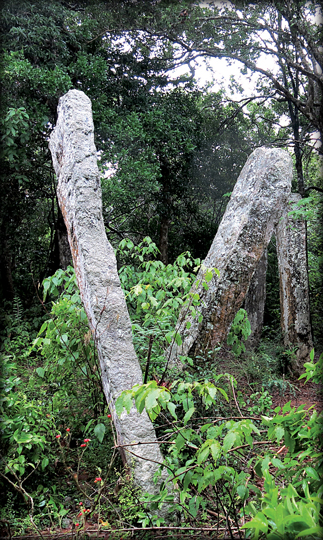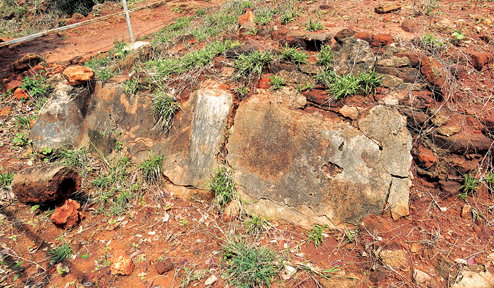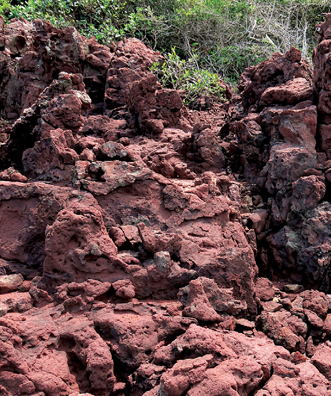|

Ruined pillars of Kuveni Palace in the heart of the Wilpattu
jungle |
Wilpattu…… in the times of Kuveni
Story and Pictures by Mahil Wijesinghe
Wide publicity is being given to Wilpattu National Park by print and
electronic media these days. Admired by local and foreign wildlife
lovers, the largest and oldest national park in Sri Lanka, Wilpattu, is
unique amongst national parks and significant because its rich
bio-diversity.
Spread across Anuradhapura, Puttalam and Mannar districts, this huge
131,667.1 hectare national park lies along the North-Western coast,
between the rivers Modaragam Aru and Kala Oya.
It was established as a National Park in February 25, 1938. The
eastern boundary of the Park located on villages such as Hunuvilagama,
Wilachchiya and Thantrimale in the Anuradhapura district.
Natural lakes
Wilpattu means ‘the land of the villus’ and derives its name from the
abundant natural lakes (Vila in Sinhala, Villu in Tamil). There are
about 40 magnificent villus within the Wilpattu National Parks, with
Kokkari Villu, being the largest, reaching a maximum depth of 10 feet.
The villu however contains salt water.
Maila Villu is the second largest at the park, but the most
interesting is the Kali Villu, historic because of its association with
the legend of Princess Kuveni. It is believed she obtained her water
requirements from this Villu
I was drawn here by my life-long love of archaeological sites. There
are historical sites in various states of ruin in every corner of the
jungle of Wilpattu.
Some of the ‘palaces’ have become home to wild animals. The beautiful
water-filled villus, once used by queens, are now bathing ponds for
crocodiles. Built by kings, they speak of a glorious past, when they
were once the capital of a dynasty. Mostly ignored and dilapidated, they
lie crumbling, waiting to tell their story. These sites have been
central to much of my work as photographer and explorer.
I felt fortunate to travel with my team of friends to Wilpattu on a
two-day tour to explore the several historical sites. Leaving Kokmotey
bungalow, we drove 16 kilometers on the sandy track in the heart of the
jungle, on a trail to the Kuveni Palace and Kudiramalai point, which is
our first destination. This was where princes and queens had left the
marks of their reign in their palaces, most of which are crumbling
today.
We were in the ancient site of Kuveni Palace. As the magnificent
ruins emerged into view in the jungle, an ensemble of stone pillars
among them greeted us.
|

Ochappu Kallu ‘leaning stone’ a deserted archaeological site
in Wilpattu jungle |
I could see the basic structure of the palace buried in the soil, yet
imposing, an example of Sri Lanka’s priceless and rich heritage. There
they were, exquisite stone pillars glisteringin the morning sun. Lying
in ruins were stone pillars believed to have been part of an edifice
that belonged to Queen Kuveni, some of them standing, some leaning on
others or buried in the earth among the huge trees dotting the jungle.
Kuveni, a demon princess of the Yakka tribe is said to have lived
here when Prince Vijaya landed in Thambapanni or Kudiramale. It is
believed that Kuveni and Prince Vijaya got married and started their
reign from this region of Wilpattu and associated legend of Prince
Vijaya.
After visiting Kuveni Palace, we snaked through the jungle crossing
many villus until we reached the Kudiramalai point on western coast of
the Wilpattu National Park. Legend has it that Prince Vijaya landed in
Lanka in the region called Thambapanni.
Standing on the edge of the cliff of Kudiramalai, I looked out and
enjoyed the panoramic view of the mighty Indian Ocean, where a steep
slope formed about 50 feet to the sea.
The geological origins of Kudiramalai are shrouded in mystery, but
general belief is that it is the site of an ancient meteor strike. The
reason behind this belief has been the unique red soil and burnt rocks
in the area. The soil contains high levels of iron and other minerals
that give it a unique reddish hue.
Kudiramalai is known as the Horse Mountain and is associated with
many historical theories. Walking further on the Kudiramalai cliff, we
could see the remains of an ancient temple which is believed to be
devoted to a horse. Some believe these as the ruins of a huge figure of
a horse that had given the region its name. It had stood 35 feet tall,
its front legs raised in the air and its rider clinging to the reins.
|

Remains of sculptured horse in the Kudiramalai cliff. |
Although most of it has disappeared, part of its rear leg with bricks
is still visible. A lantern that hung from statue was believed to have
guided ships into the port. However, today, Kudiramalai or Thambapanni
stands in memory of Prince Vijaya, who is believed to be the founder of
the Sinhala race.
Next destination
Our next destination was an archeological site called Ochappu Kallu,
which was located 59 kilometers from the park entrance. Although this
site is not well known, it is famous for its 2nd Century BC monastery
and the majestic rock carvings.
The vast stretch of land bore many caves and rock outcrops around
Ochappu Kallu archeological site filled with rocky terrain and was known
as being home to sloth bear.
A huge rock boulder lies on the top of the hill, separating it into
two. The upper rock is occupied by a vast area with a steep slope,
overgrown with trees and bushes with a brick foundation of a stupa on
the top, while the lower part has extensive remains of a temple and
another stupa, including many pillars, some still erect, others lying on
the ground. On the rock surface, there were many inscriptions in which
letters are beyond recognition due to weather elements.
The most interesting feature on the summit of the rock boulder were
two remarkable rocks called Ochappu Kallu, the ‘leaning stone’ from
where the site derived its Tamil name. These rocks appeared to be
originally perpendicular, but had by accident fallen one over the other,
and their descent arrested half-way by smaller fragments of rock beneath
and between them.
Around the vicinity of the Ochappu Kallu were a number of rock-cut
ruins, some upright, some lying flat, with other stones of various
shapes roughly hewn or simply carved, denoting the place as being an
extensive monastic edifice in the past.
The fate of two majestic stupas which adorned the landscape of the
site in the glories past, mercilessly destroyed by treasure hunters.
What caught my attention on the hilltop were the heap of rubble of two
stupas with bricks and stone scattered across extensive areas of the
rock boulder.
|

Unique red soil and burnt rock in Kudiramalai cliff. |
Looking at these ruins, what could clearly be observed was the lack
of protection and the constant threat faced by archaeological sites and
the wildlife in many areas of the park. Obviously, these spots have
become a heaven for poachers and treasure hunters.
I lost myself in the beauty of the ruins, wondering how these
structures were destroyed. Perhaps, they met their end when the human
settlements and kingdom shifted to Anuradhapura and unknown invaders
pulled the monuments down.
Another look
As I left, I took another look at ruins of Ochappu Kallu, which were
testimony to the glorious past of the island and I wondered how much of
the history lay lost in the rubble.
Another fascinating historic site is Thantrimale, which is located on
a rocky boulder in the edge of eastern border of the Wilpattu National
Park. Unlike other places we visited, Thantrimale is well known and
easily accessible from Anuradhapura via Vilachchiya. Thantirimale was
first civilised by a minister of King Vijaya called Upatissa who chosen
this site surrounded by Malwatu Oya to build his settlement then named
Upatissa Grama.
The small but beautiful Dagaba lies majestically on top of the rocky
boulder of Thantrimale. The most unique feature of this place is the two
Buddha statues carved out of living rock.
Wilpattu National Park remains beautiful and un-spoilt today despite
the gruesome and tragic events recorded in recent past.
The LTTE destroyed several bungalows and killed several wildlife
officers as well as visitors to the park during the heights of the
terror. With the dawn of peace, the park reopened on February 10, 2010. |

